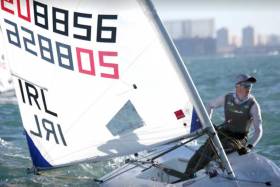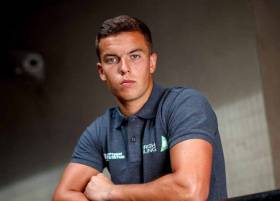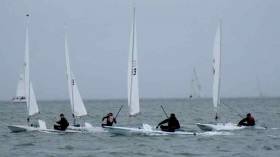Displaying items by tag: Laser
Finn Lynch Back in Second Overall in Palma, National Yacht Club Sailor Now Just Two Points off Leader
The National Yacht Club's Finn Lynch is just two points off the overall lead of the 170-boat Laser fleet in a breakthrough performance at Mallorca’s 50th anniversary Trofeo Princesa Sofia Iberostar Regatta.
A 13 and a 5 scored today in changeable conditions by the 22-year-old Count Carlow sailor have put him back into second overall after eight races sailed.
The result puts Lynch, a Viking Marine Ambassador, firmly into Saturday's top ten medal race final and with it the tantalising prospect of Ireland's first ever Laser medal from Palma.
Howth Yacht Club's Ewan McMahon, the U21 sailor competing in his second ever senior international regatta made the gold fleet and is placed 30th.
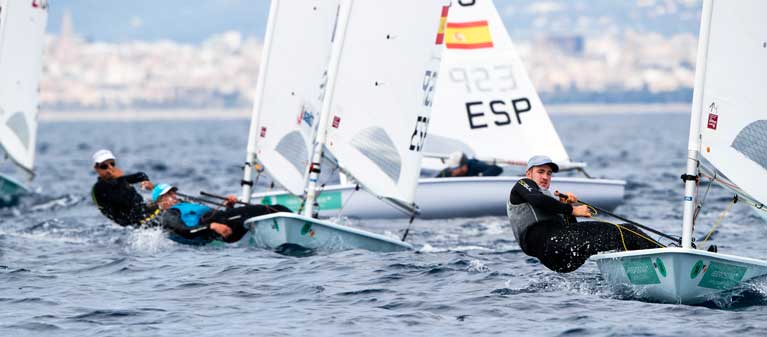 Finn Lynch (right) in control on the approach to a Windward mark Photo: Jesus Renedo
Finn Lynch (right) in control on the approach to a Windward mark Photo: Jesus Renedo
Keeping his own focus – controlling the controllables as the coaches are fond of saying - and trying not to concern himself with the performance of his selection rivals, is clearly working for the young USA sailor Chris Barnard who stepped to the top of the giant Laser fleet today. His main selection rival is 2016 Olympian Charlie Buckingham who lies eighth after today.
“Key for me today was avoiding the bad race in these crazy conditions. It was about keeping focused and composed and I managed that.” Said Barnard, “I tried to keep going fast and avoid the big risks. Our trials for the test event are Miami and here. I have to make up ten places on Charlie. I am just focused on what I need to do. I can’t control him.”
The trials for the one GBR Laser spot have five serious contenders. At the end of today three are in the top seven, Elliot Hansen vaulting into third overall as Lorenzo Chiavarini – who started the day in second – had a bitterly painful day, scoring a 34th and then a DNF which drop him to seventh overall.
“It was a terrible day. The last race I came off the start line in decent pressure and the left side was then completely cut out of wind. Then I was in a hole for a couple of minutes. It is desperate when these are the trials.” Chiavarani explained.
Past world champion Nick Thompson of GBR won the first race and now lies fifth while young Lynch holds on to second, two points off the lead.
Full results are here Check out all our Irish Olympic sailing coverage in the build-up to Tokyo 2020 here
The National Yacht Club's Finn Lynch stays top five overall in the Laser class as the split from qualifying to finals racing arrived yesterday at the Trofeo Princesa Sofia Iberostar. The strongest breeze of the regatta so far arrived as if on cue. The step up to gold fleet racing can be a blessing or a curse but for Lynch, who is having a stand out performance this week, it is definitely another blessing that follows on directly from a similarly stellar performance last January in Miami.
Norway’s Hermann Tomasgaard still leads the men, rallying to a ninth after 23rd place wobble in the first Finals race. Lynch had a 14th and a 23rd place which he discarded as his worst score to date.
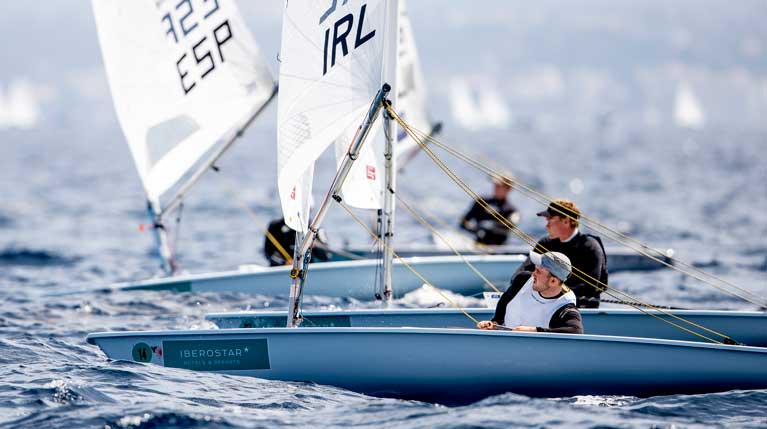 Finn Lynch is in the to top five of the 170 boat Laser class in Palma Photo: Sailing Energy
Finn Lynch is in the to top five of the 170 boat Laser class in Palma Photo: Sailing Energy
Howth's Ewan McMahon Makes Gold Fleet
In another stand out performance for Ireland, Howth Yacht Club's under-21 sailor Ewan McMahon made the gold fleet cut at only his second attempt at senior level. In fact, McMahon was racing alongside Lynch at one stage before finishing in the 20s in their 60-strong gold fleet. The 2016 Laser Radial World silver medalist has embarked on his own Olympic campaign after a string of Laser successes at youth level.
Adding to the strong showing for the British team overall today, Lorenzo Chiavarini won the second contest and lies second. Racing continues today.
Full results are here Check out all our Irish Olympic sailing coverage in the build-up to Tokyo 2020 here
Is it still the Annalise effect, now morphing perhaps into the Finn Lynch effect? Is it the Laser Master Worlds effect from last September on Dublin Bay writes Sean Craig? Is it the emergence of the Radial rig as what "Afloat" recently described as the "boat for all ages"? Is it just the latest chapter in the local rebirth of a great dinghy, driven on by an inclusive community of enthusiasts? Or is it the realisation, finally, that young and old dinghy sailors CAN and maybe must race together to share resources and give our youth sailors real race practice, rather than just endless hours of drills and theory sessions?
The answer might just be all of the above. Regardless, the end result was a great turnout of 75 Lasers with up to 60 on the water, each Sunday from November to March, comprising 37 Radials (the largest ever locally assembled fleet of the mid-sized rig in Ireland), 19 Full rigs and 18 4.7s. How great it was to also see an equally healthy entry of 40+ PY dinghies, with lots of Fireballs and good pods of RSs and Wayfarers amongst others. Getting the entries in is all well and good but the host club still has to deliver and, as you would expect after 40 odd editions, the famous old DMYC delivered in spades. This is due to superb race management (thank you rising Race Officer star Cormac Bradley) and fantastic organisation (including comprehensive market research on format) spearheaded by Organiser Neil Colin and backed up by dozens of DMYC volunteers. Nor can we forget Bob Hobby who, in between pulling marks up and down for the meticulous RO Bradley, took some fairly exquisite photos for the DMYC Frostbite Facebook page
Plenty of plaudits there already but what really warmed the cockles this winter was seeing the youthful participation of eighteen 4.7s, about a dozen Radials and even a couple of young up and coming Full rig sailors like Peter Fagan and Hugo Kennedy. Dun Laoghaire is a dinghy sailing and racing centre par excellence but for too long the generations have been kept apart on the race course, causing wasteful duplication of efforts and resources. Perhaps this was part stigma, often the dreaded Health and Safety was trotted out as an excuse but it never really made sense and great kudos is due to both DMYC and DBSC for helping local Laser organisers in this area. A real powerhouse in making this happen this winter was Rob Walker of the Royal St George, in concert with Laser class captain Gavan Murphy. Rob put together a very comprehensive youth winter training programme for the combined clubs with top coaches but, crucially, the youths knew the idea was to stop training around midday and join in the Frostbites for some great sport with the, erm, somewhat older guys and gals ! Their coach would also observe the racing for debrief later. It is to the immense credit of these sailors and their parents that they embraced all this so great thanks go to some of the most active DL sailing families like the Gormans, Fahys, Walkers, Flanagans, Coakleys, Simingtons and many others too. Some clans had 3 or 4 family members out there! Kind of amusing - watching Kitty Flanagan carving up her Dad Sean at the leeward mark! Nice also to see something similar in PY with Morgan Lyttle in his 420 and the Thompson lads up from Wexford and storming around in a Fireball.
Results somehow don't seem very important when one has the gut feeling something rather special just took place in terms of the tribe on the water each Sunday. But for those of a statistical inclination, follow this link here What is perhaps noteworthy here is that the famous old Laser Frostbite trophy went to Conor Gorman who held off a strong field in the 4.7 division. By the way, older Laser heads learnt a hell of a lot by watching those guys start! No lining up from 3 lengths out with these racers. Anyway, the point is that this great old trophy (won by Olympians for example) has always been awarded to the Full rigs since the smaller sails simply didn't exist 40 years ago! But the senior sailors were unanimous this year that it should go the 4.7s to recognise their arrival in such good numbers and here's hoping we see 30 or 40 of them next winter! Indeed, the aforementioned DBSC welcome all ages and Laser rigs for their DBSC series (Tuesday nights) starting April 23rd here
Thanks again to the DMYC and all the competitors for turning up. What a fantastic bounceback from a couple of years ago when we were hearing a cruise-liner pier carving the harbour in two was no big deal since dinghy sailing was dying out anyway! Nothing could be further from the truth these days. Frostbiters are joined each Winter weekend by team racing students in Fireflies, Oppie training, Topper training, INSS and SID dinghy fleets and plenty of brand new 29-ers and Waszps, tearing around the harbour. With the brand new IS High-Performance centre on the Irish Lights site as well, you'd be tempted to ask if there's a more vibrant dinghy hub anywhere in the world? And that’s even before thirty Water Wags hit the water for Summertime!
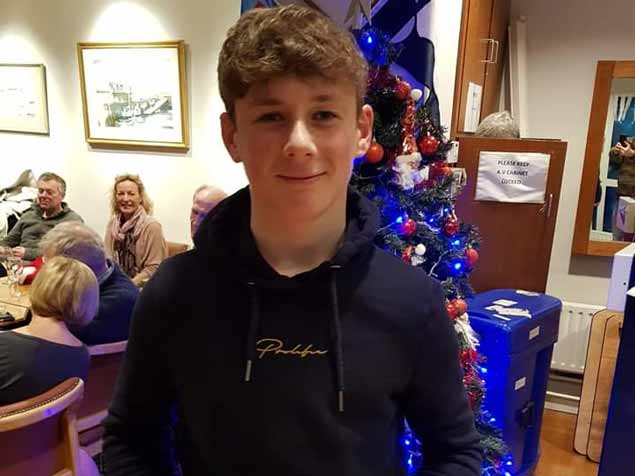 Conor Gorman (left) with the famous Laser Frostbite Trophy. Photo; Bob Hobby
Conor Gorman (left) with the famous Laser Frostbite Trophy. Photo; Bob Hobby
Read Afloat.ie's weekly DMYC Frostbite reports here
Royal Saint George Yacht Club and Under 17 sailor Tom Higgins won the Andalusian Olympic Week regatta in the Laser Radial class earlier this month.
Higgins recorded three first places and three-top three finishes overall to secure a five-point net winning margin. Sailed over four days in mixed conditions in the Bay of Cadiz Tom was part of the Academy sailing team of five sailors coached by Sean Evans. Since his return, Higgins was part of the Gonzaga Sailing team which won the Leinster Team Racing Championships held in the RStGYC earlier this month.
As well as some Europa Cup events over the next number of months the team are preparing for the Laser Radial World Championships in Kingston, Ontario. Tom finished second U17 and seventh overall at this event in 2018.
Dickson & Waddilove Out of Palma Competition Due to Injury
Consistent sailing will be the key if the Irish Olympic sailing team is to make good on promises of a strong peformance on the Bay of Palma this week. While none have yet reached the qualification standard for Tokyo 2020, the group, a mix of male and female Laser and Skiff campaigns, are now launching into a challenging season where securing a berth on the Tokyo startline is the absolute priority and for most of them this starts here at the Trofeo SAR Princesa Sofía regatta.
As probably the most popular annual Olympic classes regatta in the world it is no surprise that the 50th anniversary Trofeo SAR Princesa Sofía Iberostar has drawn a record fleet to the Bay of Palma.
Nine of the ten Rio 2016 Olympic gold medal-winning sailors or pairs are racing at the Trofeo SAR Princesa Sofía Iberostar.
In action for Ireland are Laser men, Finn Lynch, Liam Glynn, Ewan McMahon as well as 49er skiff team Ryan Seaton and Seafra Guilfoyle. Afloat.ie Sailor of the Year Rob Dickson was meant to sail but sailing partner Sean Waddilove is now out due to injury it has been confirmed tonight by the team. Also racing are National Yacht Club brothers Sean and Tadhg Donnelly.
As Afloat.ie previously reported, although Ireland has still to qualify for Tokyo in any class, once the nation is qualified, Irish sailing's trials criteria means finishing in the top half of one of the 2019 qualifying regattas that include Palma. What's more, next week's Spanish regatta has added significance as it is the first of two trial events in the Laser to determine which Irish sailor will attend the Tokyo test event in August.
Dun Laoghaire's Finn Lynch, in particular, will be keen to continue his early season form. In Miami, in January, for example, he became the first ever Irish Laser sailor to qualify for a World Cup Medal Race, a sign perhaps that qualification is on the cards for the Rio veteran later this season?
Unfortunately, however, despite the opportunity for some excellent competition this week Annalise Murphy and Katie Tingle in the 49er FX will not be competing. The Irish Laser Radials are not in action either, due to exams, thus making a challenging qualification season now even tougher.
Club Nàutic S’Arenal
The golden jubilee regatta has mustered 1,224 sailors, 869 boats in ten classes all from 67 different nations the huge Olympic classes competitions congregate over eight race areas administered from the sailing clubs the Club Nautico S’Arenal and the Club Marítimo San Antonio de la Playa,
As the Princesa Sofía Iberostar reaches its remarkable landmark the celebratory ambience around the boat parks and the clubs gives way Monday to the business of racing.
This annual gathering of the clans and the classes on the Balearic Island of Majorca is always a vital first check in with the rivals, the earliest big fleet opportunity to benchmark improvements after the winter period of training and racing. Or in some cases it is the idea arena to return to Olympic classes competition arena after a more protracted post-Olympic break.
A glittering 50th anniversary gala on Saturday evening was hosted at the Son Termes estate and was attended by Her Majesty Queen Sofïa. It was attended by Spain’s Minister of Industry, Commerce and Tourism, Reyes Maroto, the president of the Government of the Balearic Islands, Francina Armengol, and the president of the World Sailing (International Sailing Federation), Kim Andersen.
Queen Sofia offered a few words of thanks and congratulations "To all those who over these 50 years have made it possible for this regatta to be run in such a wonderful way on the unrivalled waters of the Bay of Palma, setting up this trophy as a national and international reference in the sport of sailing ".
HM Queen Sofía also offered special recognition for Rear Admiral Marcial Sánchez Barcaeiztegui and Jaime Enseñat who are considered the originators of the regatta.
Jaume Carbonell, who was the Trofeo Princesa Sofía event manager over two periods (1988-92 and 2004-11) praised Enseñat, who was president of Mallorca Tourism Promotion in 1968.
“He had the idea of the island benefitting from the promotional value of a major sports event to put Mallorca in the world map as an emerging tourism destination back then”.
Enseñat was, according to Carbonell, a pioneer of sports sponsorship.
“He ensured that for the first time that a private company gave its name to the Trofeo Princesa Sofía and invested some money that enabled thinking big and set the foundations of what today is the best Olympic classes’ regatta in the Mediterranean and probably in the whole world”.
“Thanks to this, the Princesa Sofía changed from being a Club regatta to become Mallorca’s showcase regatta, known all around the world”, said Carbonell.
Nine from Ten
Nine of the ten Rio 2016 Olympic gold medal winning sailors or pairs are racing at the Trofeo SAR Princesa Sofía Iberostar.
Since they won the 49er gold medal in Rio in 2016 New Zealand’s Peter Burling and Blair Tuke have won the America’s Cup and competed in the Volvo Ocean Race round the world. As they set out to defend their Olympic title next year in Tokyo Burling and Tuke return to the 49er fleet for the first time since Rio, choosing the Trofeo SAR Princesa Sofía Iberostar and the Bay of Palma as their first major event after training at home during the New Zealand summer with a flourishing Kiwi 49er squad. Blair and Tuke will have a fleet of 107 49ers, a class record, to contend with on their return.
“We are here to get back into it. We have had really good training group at home, it has been fun there but it is good to be back into it in Europe. We have a good few blocks of time at home, we feel pretty comfortable in our handling, it is about making sure you get these little details back which will I am sure will come back. It is cool to see the fleet so big and probably reflects a bit what is going on what is happening in the rest of the sailing world. It is looking pretty secure for a while.” Burling, who won the title here with Tuke in 2015 when they were last here, says,
“It is fun sailing here and with the Cup stuff we have on it is good to do some sailing. Andy (Maloney) and Josh (Junior) from our Cup team are doing Olympic campaigns and are here too. It fits in well with our programme and it is quite similar to what we did last time, a good balance some design time, some big boat sailing and some little boats. It is all part of the plan.
Following a similar programme is Great Britain’s Giles Scott, with Ineos Team UK hoping to wrest the America’s Cup from the Kiwis, and looking to defend the Finn gold medal title which he won in Rio. Scott has done three Finn regattas since he won here last year, two lower level regattas in Australia this winter and the Enoshima Japan 2019 World Cup series opener last September where he finished runner up.
“At the end of last year we went to Australia and did a couple of trips there and then came up to Palma in February and have been in and out since then. So I have had some reasonable time in the boat since then which is nice after the last 18 months or so.” Says Scott, “At the moment I can manage the Cup programme and this alongside each other. It will not get any easier from that point of view. It is working fine. I don’t know where I am with regard to the fleet and so that is what we come here for. It is great to have this regatta. Everyone goes off through the winter and it is nice to come back and see what everyone has done. For me the best thing is being properly back into it and feeling good.” Says Scott,
“I do love it here. It is amazing. Formats change, World Cups come and go, and this is the constant. Everyone always comes. Everyone always loves it. They always put on a good regatta here. And so the sailors always respond to that and turn up in their masses.”
Argentina’s Olympic Nacra 17 champion Santi Lange has lost count of the times he has been to the Trofeo SAR Princesa Sofía Iberostar.
“It is a lot more than twenty.” Smiles Lange who with crew Cecilia Carranza Saroli finished third in Miami in January and third at last year’s World Championships, “Everyone is so passionate and supportive here it is always great to be here. In the ‘good old days’ everything was brought here by the military and a lot of things were provided free. I once did this regatta when I was working in Southampton and came by train. I remember being at Victoria Station in London at 5am in the morning, travelling with mast, boom, daggerboard, rudder and everything. We were crazy to be here.”
Lange adds: “It has changed a lot but this I am always happy to be here. It is all so much more professional now than it was but this is such a cool place. There are cheap places to stay and it is a great place for training camps. And this is such a good regatta for younger sailors to come and race with the best in the world. That used to be the case in Hyeres, Spa, Medemblik and now it is not and this is what there is. I do think we should keep pushing to have big regattas where newcomers can come and race against the good guys and girls.”
“For us we have come here a little late and so our first thing is to check in with the fleet and see where we are, and then we fix our objectives. We had some good training in Uruguay with a good group. This is a technical class where everyone is learning and improving all the time.
Who’s who?
The 470 Men’s class has 73 entries. Winners here in 2018 were Australia’s Olympic silver medallists Mat Belcher and Will Ryan who return to open their season on the Bay of Palma. The world champions Kevin Pepponet and Jérémie Mion (FRA) finished seventh in Miami in January and are among a 13 strong French 470 mens squad. In Miami it was Spain’s Jordi Xammar and Nicolas Rodriguez who prevailed.
In the 470 Women’s fleet there are 45 entries. Japan’s Ai Kondo Yoshida and Miho Yoshioka are World Champions and won here last year. Olympic champion is GBR’s Hannah Mills who sails with Eilidh McIntyre. Germany’s top two 470 crews finished first and second in Miami, Loewe and Markfort winning from Oster and Winkel. Mills and McIntyre were fourth at the Miami World Cup.
In the 45 boat Finn class Giles Scott is the defending Sofia champion and the Olympic champion. Sweden’s Max Salminen won in Miami, was World Championship runner up in Aarhus. World Champion Zsombor Berecz is not entered here.
The 108 strong 49ers see the return of Burling and Tuke, the Olympic champions. World champions 2018 are Croatia’s Sime and Mihovil Fantela. The winners here in 2018 were Yago and Klaus Lange (ARG).
Over 180 Laser standards are entered. Cypriot Pavlos Kontides stands out as world champion in 2017 and 2018 and Olympic runner-up in London 2012 and winner in January in Miami. Olympic champion is Australia’s Tom Burton while Miami’s dominant winner was Norway’s Tomasgaard.
In the Laser Radial there are 120 sailors and favorites Marit Bouwmeester the Olympic gold winner from Rio 2016 and the Belgian Emma Plasschaert, current world champion.
In the 49er FX, Annemiek Bekkering and Annete Duetz (Holland) are looking to defend the title of Sofía Iberostar champions. They are also the current world champions. Winners in Miami were Brazil’s Martine Grael and Kahena Kunze, Olympic champions.
Italy’s Ruggero Tita and Caterina Banti are world champions who start as favourites in the Nacra 17 class which has 59 entries. France’s four times World Champions Billy Besson and Marie Riou return to race in Palma after Riou raced on the Volvo Ocean Race last year. Olympic champions are Lange and Cecilia Carranza Saroli. Australia’s Jason Waterhouse and Lisa Darmanin won in Miami.
The RS: X male and female classes see this regatta as a prelude to the the European Championship that will take place at the Club Nàutic S'Arenal immediately after this event, from 8 to 13 April. The current female windsurf world champion, the Dutch sailor Liliana De Geus, who also won the 2018 edition of the Sofía Iberostar, will be the rival to beat the Japanese Peina Chen and the Andalusian Blanca Manchón as main competitors.
On the male windsurfing side, the Spanish sailors such as Canarian Ángel Granda and the Balearic Sergi Escandell at the head, is emerging as one of the main powers in the Majorcan regatta.
Due to heavy winds, the annual Howth Yacht Club ‘Round the Island’ Laser Race was postponed last weekend until this Saturday, 16th March writes Dave Quinn.
Entry is still open, with the first gun scheduled for 10:55. We plan on having a Windward Leeward Race first, before the main event. Lunch and prizegiving is planned for 1:30, which should allow for viewing of the Ireland V Wales match afterwards on big screens in the bar.
Winter Laser Sailing – A Hidden Gem of the Irish Sailing Scene
While most sailors pack up their boats in October and look forward to a cosy and relaxed winter, there are a few hardy sailors who actually look forward to the Winter months writes Dave Quinn. The Laser dinghy was unveiled in 1971 at the New York Boat Show. Frostbite sailing has been a fixture on many club calendars since the mid-’70s, with fleets mostly comprising Lasers in venues other than Dun Laoghaire. Recent years have seen an impressive increase in numbers around the country and this success should attract the attention of those trying to grow the sport. From my perspective, the appeal of Frostbite sailing is the convenience. Given the time of year, racing tends to be around short courses, with quick turnarounds, convenient start times and a focus on fun. We have compiled some reports from around to country to give some background to Frostbite sailing in the various centres, and an insight into the current success of the winter sailing scene.
Dublin Laser Sailing
In Dublin, there are two main winter sailing centres, Howth and Dun Laoghaire. The Howth Winter ‘Frostbite’ Series, which is the oldest in Ireland, has been running since the Autumn of 1974. John Gore-Grimes first identified that the Laser, with its sturdy design, easy transport options and low maintenance offered a unique opportunity for Howth sailors to race regularly through the winter. The first races were held that Autumn and this marked the start of year-round sailing in Howth Yacht Club. Vincent Wallace won the first two series, with the familiar names of Anthony Gore-Grimes, Robert Michael, Neville Maguire and David Dickson all featuring.
 Early photo of Laser racing from inside Howth Harbour
Early photo of Laser racing from inside Howth Harbour
Racing was originally held in the harbour, similar to Dun Laoghaire now, but once the new harbour development was completed, racing moved outside to the channel between Howth and Irelands Eye. Such was the popularity of the years' Frostbite series that Laser International declared it the biggest Laser Club series in Europe. Since those early years there has always been a large winter series fleet in Howth, which has attracted some of the top laser sailors of the day Once the series moved outside the harbour, racing was mostly held off a fixed start line from the starters hut at the end of the west pier (which can still be seen today next to Aqua restaurant). This often led to reaching starts, and huge amounts of fun. I distinctly remember a certain Gavan Jones approaching the line from above, calling Starboard on the entire fleet, reaching towards the line on port! In more recent years, the format was improved with a dedicated committee boat, 2 races a day and high-quality courses. The series ends each year with the unique ‘Round the Island’ race. This is a single lap race, around the Island, with a twist. Sailors can go either way round. Tides, Winds, Eddies and Wave patterns all dominate sailors minds in the week running up to the big race. One side always wins out, although its not always that obvious. This is one of the most prestigious and sought after trophies in Howth Yacht Club. Simon Knowles currently holds the record for the most number of wins, at 4.
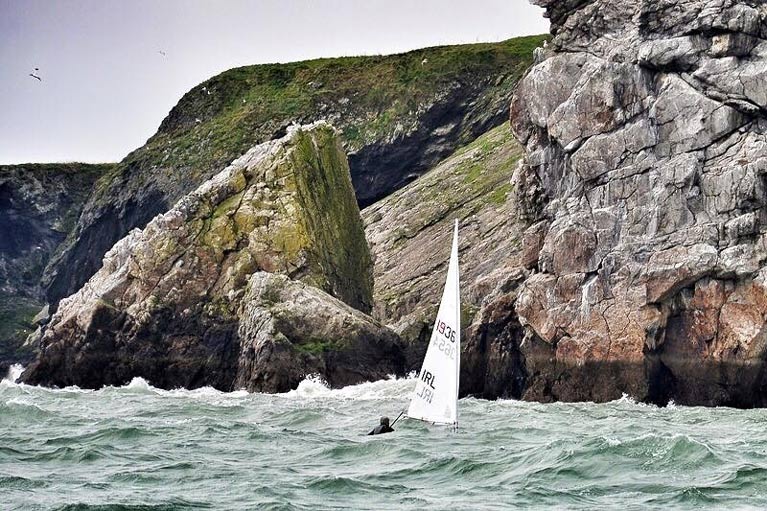 Laser racing Round Ireland’s eye in the annual Round the Island race
Laser racing Round Ireland’s eye in the annual Round the Island race
The now 49-year-old DMYC Frostbite series (next year is the big Five-O) has seen a monumental increase in Laser entries this season in Dun Laoghaire Harbour. The first series kicked off on Nov 04th with a whopping 61 lasers entered across the 3 rigs. This marks a 154% increase on the 2017/2018 season. Such was the volume of entries, the DMYC organisers and laser representatives agreed that it would be wise to merge the standard and 4.7 rigs and give the radials their own start. What has been most encouraging to see has been the number of youth sailors taking part in the series. This came about as a result of ongoing dialogue between the Laser reps, parents and youth coaches where it was highlighted to them that the quality of racing and organisation on the water was worth their investment as it would give them plenty of starting and race management practice, not only amongst their peers but amongst some of slightly ‘saltier’ dog’s too! The genuine willingness of the DMYC frostbite organisers to accommodate the laser class has also been a major factor in the success of the series to date. Special thanks must go to Neil Colin and his team. They have not only facilitated our wishes to provide both windward/leeward courses but triangular too. This has been lapped up by the competitors as it has enabled them to get much-needed race course practice in the winter, keeping them sharp and fit. The more ‘mature’ sailors have been surprised by the push for the line by their younger competitors with 2 minutes to go, making the starts a somewhat nerve-wracking experience for some! As you can gather, the laser fleet is alive and well in Dun Laoghaire and is super excited about the prospects the future holds!
Belfast Laser Sailing
In late 1974, Ron Hutchieson brought the first Laser to Ballyholme. In conjunction with Trevor Millar and a few others, by 1976, permission had been granted for racing at Ballyholme during the closed season with a short winter break in January. Initially, a practical break allowing for maintenance and recovery of tired rescue drivers (and presumably sailors). It now serves as a convenient time for half of the fleet to go skiing!
In 1977, a small drinks Ice Pick from Harrods was purchased and mounted as the overall prize. The “Icebreaker,” was born. In the following years, the Icebreaker grew both with racing for lasers, but also GP14s, and Enterprises. In the mid-1980s twenty to twenty-five lasers were regularly seen racing, with stalwarts past and present of the class and indeed Northern Irish and Irish sailing being amongst the fleet. At this time Gareth Flannigan often took home the trophy, but Chris Boyd, Charlie Taylor, Bill O’Hara, Brian Spence, Elaine Taylor and the late Denis Finlay were regular competitors.
In the 1990s and 2000s, Laser sailing boomed at Ballyholme, with many top sailors coming through the Icebreaker as we know it today. In the early 2000s when I joined the fleet, the front of a Sunday Icebreaker often resembled the front of the regional qualifiers with the McGovern brothers, James Espey, Bill O’Hara, Gareth Flannigan, Chris Boyd and Peter Kennedy sharing the spoils locally as well as more than a few regional and national championships.
More recently, the resurgence of the class in Ireland as a whole and the efforts of the committee to bring more Masters back to sailing the Icebreaker is going strong. Locally in Ballyholme, the efforts of Garth Maxwell to support and encourage those returning seem to know no bounds. At times upwards of forty boats, but usually nearly thirty race each week. Tough competition is seen in gold, silver, bronze and radial fleets with many old names returning to the fray. The ever-shrewd Chris Boyd remains more often than not at the front of the fleet, as any Masters who raced in Dun Laoghaire last year will be aware. John Simms, and his son Conor spar with each other weekly, and this year has seen the return of Matthew and Russell McGovern to racing alongside the occasional appearance from multiple former national champions. Further down the fleet, the racing is if anything tougher and more vicious as bragging rights are often so much more valuable than series results. The Ballyholme Icebreaker is in rude health and seems fit to continue its increase in standard and numbers taking part.
Cork Laser Sailing
Down in Cork, the laser fleet has thrived for many years. Since the mid-1970s, the fleet has grown into what it is today.
The Cork Laser fleet has proved to not be exclusive, with events held all year round that are tailored to suit each individual sailor. As a result, the number of laser sailors on the water over the past few years has been high.
The most popular events are usually the annual frostbite leagues, hosted by several Cork-based clubs. These include Kinsale, Monkstown and Royal Cork, to select a few. These leagues can attract all kinds of competition from a parent looking for a break, to the local club hotshot.
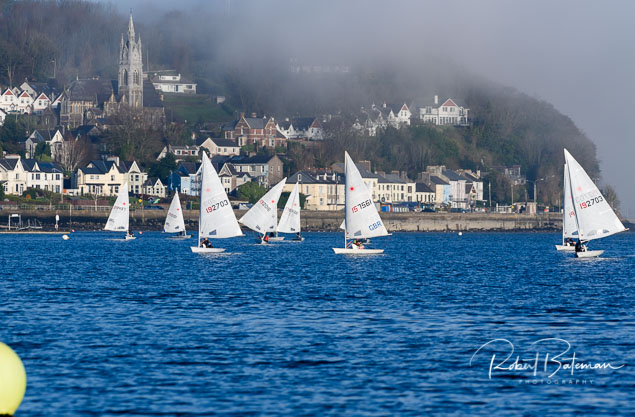 Cork Harbour Laser Racing at Monkstown Bay Photo: Bob Bateman
Cork Harbour Laser Racing at Monkstown Bay Photo: Bob Bateman
Cork has an ever-expanding mix of Master and Youth sailors. Ever since the smaller sail plans were introduced, youth sailors in Cork have increased in number over the years. In conjunction with the rise in youth sailors, more experienced Master sailors have been dusting off their lasers and taking to the water.
The “youth” sailors tend to be very competitive about their racing. The Master laser sailors are very competitive in their own right, but prefer a friendly environment adopting a “Life is too short” attitude. This created a slight divide in the fleet, which then led to the organisation of a Laser frostbite series hosted by Monkstown Bay sailing club. Only standard rigs could compete at the time. This event suits the Master laser sailor, with short amounts of time on the water and fun racing. The youth sailors annually converge in October for the Royal Cork frostbites, where they compete for top spot in heated competition.
Every year the Cork Laser fleet continues to grow in size, including recreational sailors, Masters and youths.
Wexford Laser Sailing
Wexford is another well-established centre for Winter Laser sailing. They have been running a winter series since the late 1980s with 20 to 30 boats out on average. They also follow a common theme to the other series with racing on Sunday mornings at 11, and the series running from November to the end of April. They welcome visitors from as far as Blessington, Courtown, Dunmore East and Wicklow.
Overall it appears that winter club dinghy sailing continues to be a very important and successful aspect of our sport, covering a 6 month period where there is very little other activity in many centres. The short races, convenient start and finish times and low cost offer some valuable lessons to our sailing administrators and clubs at a time when we are trying to retain and grow our younger membership numbers.
The author wishes to acknowledge the assistance of Colin Leonard and Ron Hutchieson (Ballyholme), Chris Bateman (Cork), Gavan Murphy (Dun Laoghaire), Ronan Wallace/Paul Ebrill and James Sinnott (Wexford) in the compilation of this article.
Howth Yacht Club Laser Frostbite Series Drifts to Soggy End
When the 17 boat fleet followed the Race Committee out into Howth Sound for the last day of the Laser Frostbite Spring Series they found the wind following its forecast pattern of slowly working its way from south to north while increasing from very light to something more robust and the rain pouring down. With a strongly ebbing tide adding to the mix, it looked like nature had decided to make the final day of the Laser Frostbite series extra challenging.
After the Race Committee had quickly relaid the course twice with the AP displayed and deciding that it was either make the most of the conditions or abandon, the fleet was started using a Black Flag and all got away cleanly.
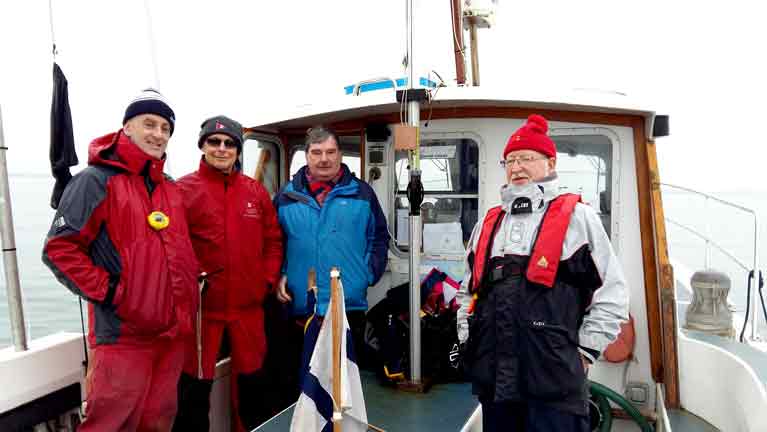 The dedicated and hard working HYC Race Committee for the Series - left to right are R. Kissane, D Jones, J Doran and L Dinneen. Not pictured are H Gallagher and N Murphy.
The dedicated and hard working HYC Race Committee for the Series - left to right are R. Kissane, D Jones, J Doran and L Dinneen. Not pictured are H Gallagher and N Murphy.
The wind, all four knots at a maximum, was arcing from 150 to 210 and provided the sailors with plenty of opportunity for inspired choices (or guesses?? ) of which way to go and what was really a header or lift. Darragh Sheridan got all the choices correct and he rounded the first mark with a big lead. He protected it all the way around the next two legs before finding that one lap and a short beat to the finish had been decided to be enough punishment for the fleet. There was no hope of a second race in the conditions and thus ended the Laser Frostbite Series of 2018 - 2019.
"Ronan Wallace collects the Rowan Trophy for winning the Standard Rig fleet after a very close battle with Daragh Kelleher all series"
This concludes our Spring Series, with Ronan Wallace collects the Rowan Trophy for winning the Standard Rig fleet after a very close battle with Daragh Kelleher all series. Tom Fox won the Radial Trophy, discarding a second and Sophie Gilmartin won the 4.7 fleet prize.
Huge thanks and appreciation must go to the Race Committee team of Harry Gallagher, Neil Murphy, Richard Kissane, Liam Dinneen, John Doran and David Jones. We are very lucky to have such an experienced and dedicated group looking after our very long series, which runs from the start of November to mid-March. They are out on the water, in a volunteer capacity, every week throughout the winter, giving the sailors national championship levels races courses and organisation week in week out.
We now look forward to the annual Round the Island Race next Saturday morning. This unique event should be on the bucket list for any Laser sailor. It’s a huge amount of fun, and the Skehan Trophy is considered one of the most highly sought-after and prestigious trophies in Howth Yacht Club. This is an open event, and anyone looking to join the fun can enter here
Video of yesterday's single start:
Laser Dinghy League at Howth Yacht Club: Clear Winners in Foggy Conditions
For the first time during the series, the 18 boat turnout for the penultimate race of Howth Yacht Club Laser Frostbite event found themselves having to contend with fog. Adding to the challenge conditions were a strong tide and wind ranging in direction from 140 to 170 and from the 4 knots the fleet found in the Sound when they left the Harbour to a brisk 21 knots in the occasional gusts.
In both races Darragh Kelleher and Ronan Wallace battled it out at the front of the fleet all the way around the lap, sausage, lap course. In race 1 they swapped the lead three times before Ronan took the gun. In the second, Ronan grabbed the lead early on and used his off-wind speed advantage to build a comfortable lead before again crossing first. Behind them there was close racing all the way through the fleet. Conor Murphy took third place from Stephen Quinn in race 1. In race 2, Stephen's individual recall damaged his chance of a repeat and Mike Evans took third from Conor Murphy. Tom Fox took first place in the Radial fleet in both races.
Next Sunday sees the final two races being sailed, leading to the season climax, the Round the Island race, on Saturday, March 9th
Rules Class with Bill O'Hara for Irish Laser Academy Sailors in Cadiz
It might be Mid-term holidays for some but sailors in the Irish Laser Radial Academy still have classroom work!
Pictured above is a rules session led by International judge and race officer Bill O'Hara, a 1984 Olympian in the Finn class.
The week-long camp in Cadiz, Spain includes the National Yacht Club's Carmel Winkelmann Cup winner Clare Gorman, Jamie McMahon, Eve McMahon, Tom Higgins and Micheal O'Sullivan.
The Academy is Joined by Tokyo Olympic trialist, Aoife Hopkins who competes in Andalusia Olympic Week next week.






























